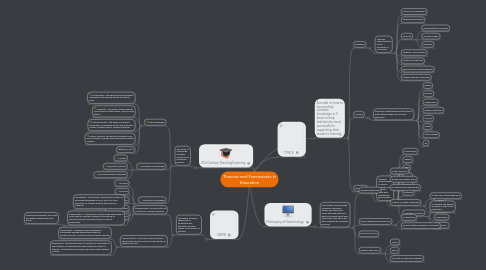
1. 21st Century Teaching/Learning
1.1. The types of knowledge students require to be successful learners
1.1.1. Meta Knowledge
1.1.1.1. Collaboration: the ability to work efficiently and flexibly with diverse groups to achieve goals
1.1.1.2. Creativity: the ability to generate and improve upon original ideas, alone or with others
1.1.1.3. Communication: the ability to transmit information, knowledge and/or skills through a variety of media and for multiple purposes
1.1.1.4. Critical Thinking: the ability to problem solve, and to analyze, evaluate and understand complex systems
1.1.1.5. (Edutopia, 2012)
1.1.2. Foundational Knowledge
1.1.2.1. Content
1.1.2.2. Information literacy
1.1.2.3. Cross-disciplinary knowledge
1.1.3. Humanistic Knowledge
1.1.3.1. Life Skills
1.1.3.2. Job skills
1.1.3.3. Cultural Competence
1.1.3.4. Emotional Quotient
1.1.3.5. Ethics
2. SAMR
2.1. The extent to which technology is integrated into education and the quality of its impact on learning
2.1.1. Enhancement: may have little to no impact on student learning
2.1.1.1. Substitution: technology replaces other modes of delivering knowledge or skills, but is no more impactful on student learning than previous methods
2.1.1.2. Augmentation: introduction of technology brings with it some specific benefits, whether in the saving of resources, time to accomplish task or ease of assessment
2.1.1.2.1. Enabling sick students to access homework assignments from home.
2.1.2. Transformation: may have some impacts to significantly positive impacts on the quality of student learning
2.1.2.1. Modification: changes in how knowledge is transmitted through technology enhances student learning. Learning is more student-centred.
2.1.2.2. Redefinition: technology allows for delivery of knowledge or skills hitherto unachievable through traditional modes of delivery. Collaboration is required; learning is highly student centred.
3. A model on how to successfully combine knowledge in 3 areas to help teachers be most successful in supporting their students' learning
3.1. Pedagogy
3.1.1. Teachers' understanding of the principles of instruction
3.1.1.1. classroom management
3.1.1.2. assessment practices
3.1.1.3. inclusion
3.1.1.3.1. differentiation techniques
3.1.1.3.2. universal design
3.1.1.3.3. readiness
3.1.1.4. students' learning styles
3.1.1.5. multiple intelligences
3.1.1.6. developmental appropriateness
3.1.1.7. student-teacher relationship
3.2. Content
3.2.1. Teachers' understanding of the subject areas being taught and curricular standards
3.2.1.1. English
3.2.1.2. Français
3.2.1.3. Mathematics
3.2.1.4. Physical Education
3.2.1.5. Science
3.2.1.6. Health
3.2.1.7. Social Studies
3.2.1.8. Art
3.3. Technology
3.3.1. Teachers' understanding of how to operate and problem solve with educational technologies
3.3.1.1. SmartBoards
3.3.1.2. laptops
3.3.1.3. iPads
3.3.1.4. clickers
3.3.1.5. Twitter
3.3.1.6. Pinterest
3.3.1.7. Computer Programs
3.3.1.7.1. Glogster
3.3.1.7.2. GoAnimate
3.3.1.7.3. MindMeister
3.3.1.7.4. many more...
4. TPACK
5. Philosophy of Teachnology
5.1. Philosophy of teachnology combines a teacher's beliefs and aspirations about teaching with their hopes and ideas about how technology may help them best support their students' learning.
5.1.1. Includes technology
5.1.1.1. in the classroom
5.1.1.2. as part of teachers' PLNs
5.1.1.3. in Professional Development
5.1.1.4. in terms of digital citizenship
5.1.1.4.1. in their own online behaviours
5.1.1.4.2. in teaching and guiding students in their online behaviours
5.1.2. May be expressed and explored
5.1.2.1. in reflections
5.1.2.2. as part of their philosophy of teaching
5.1.3. Evolves over time
5.1.4. Impacts their use of
5.1.4.1. TPACK
5.1.4.2. SAMR
5.1.4.3. 21st century teaching strategies
